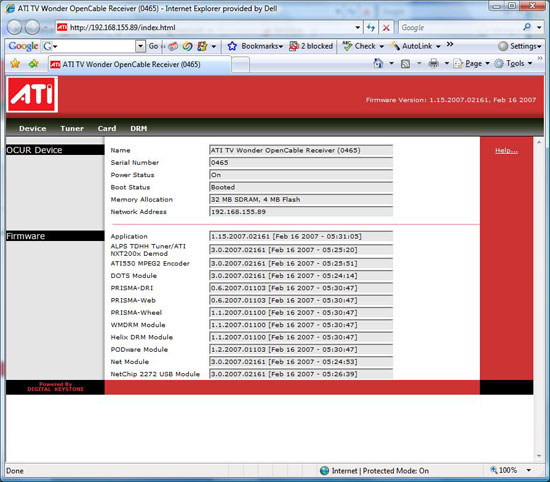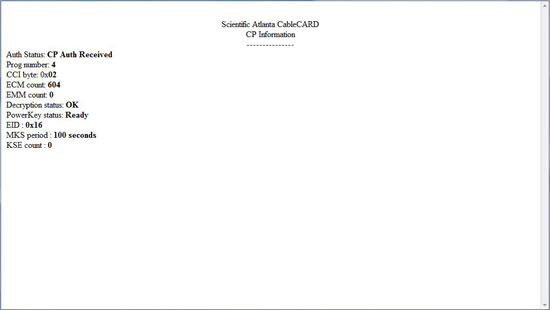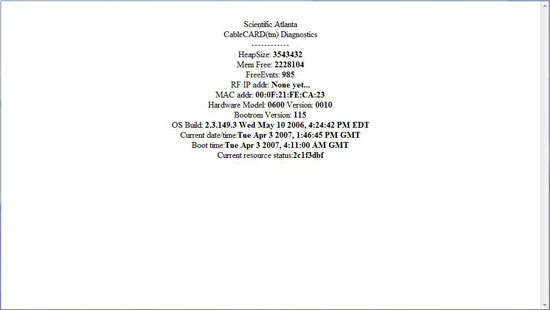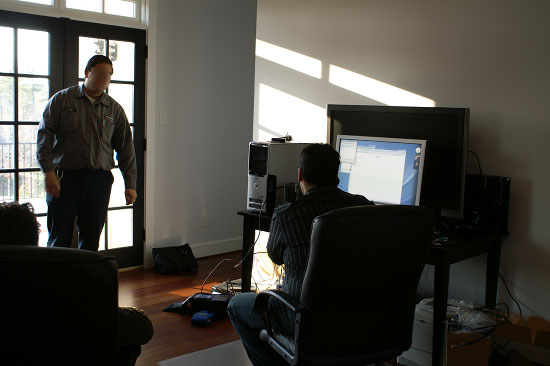ATI TV Wonder Digital Cable Tuner: AMD and Dell Bring CableCARD to PCs
by Anand Lal Shimpi on April 3, 2007 11:37 AM EST- Posted in
- GPUs
The Installation: Day One
Prior to Dell's arrival we had a handful of telephone conversations and email exchanges to clear our intentions for this article. Dell is used to dealing with sending review samples of complete systems that it has built and tested time and time again. Dell was not used to sending a platform out that was buggy, not yet ready for prime time and dependent on a cable network that it had absolutely no control over. In short: Dell was nervous.
Dell asked us if it was alright if a handful of representatives accompanied the system to our office in North Carolina, just to make sure things went smoothly. We didn't anticipate any problems but said that if it made them feel more comfortable, they were welcome to oversee the initial setup. From our perspective the setup couldn't be simpler: 1) Setup the system, 2) Insert CableCARD, 3) Watch TV. It turned out that we were a bit optimistic.
Even though it had been over a year since we first saw OCUR demoed, the devices and platform as a whole weren't perfect. The problem is that proper operation depends on far more than just a piece of hardware and its associated driver. With OCUR, you have the usual hardware and software problems, but then you've got issues with wiring at the location. Is the signal coming to the coax port sufficient for OCUR? We found that what was sufficient for a Scientific Atlanta HD-DVR wasn't necessarily enough for proper OCUR operation. Then there are issues with the actual cable network the device is running on. Each cable network is slightly different and we found that these devices don't always behave similarly across different networks. Then there's Dell, a company that at best can only control how the system was built and what hardware went into it; a company that was tasked with taking the brunt of any problems that crept up at ground zero when we set up the OCUR system.
Dell came prepared; upon landing at RDU International Airport, we got a call asking if it was okay if a Time Warner technician was present during the install to help with any problems. The more the merrier we thought, so Dell made a phone call and a Time Warner technician was present. As a side note, the last line was exactly how it happened. Apparently the magic number Dell called dispatched a Time Warner technician to what is known internally as a "VIP Customer". There were no vague time windows, no waiting, and no arguing; just a phone call and poof: instant technician. After discovering this magic ability that Dell possessed, we asked Dell to move in with us permanently. Regrettably Dell declined and its representatives did not confirm whether or not they had similar influence over the local phone or utility companies.

When you're Dell, TWC comes with lights and sirens blaring
For the first part of the setup, Dell was quite ambitious. Gary Lusk from Dell was the resident performance engineer on site (aside from yours truly), and he had hand carried two ATI TV Wonder Digital Cable Tuners with him from Austin. Figuring that nothing could go wrong, he confidently hooked up both tuners and began the configuration process. Both tuners required a firmware update provided by AMD; however that won't be a step that end users will have to worry about once these things make their public appearance.

The TV Wonder DCTs appear as Network devices
The tuners were detected by Vista, which has a built in driver for them. As a side note, Microsoft (not AMD) wrote the Vista driver for the TV Wonder DCT, so any driver bugs are actually Microsoft's responsibility and not AMD's. Each OCUR device actually appears as a Network device in Vista. Each OCUR has its own IP address, which if you visit in a web browser you get a configuration website served from the OCUR. The configuration pages give you the necessary information that your cable provider will need to activate your CableCARD(s); however, this information is also accessible through Vista's media center interface. The configuration pages are a bit more robust and will let you do much more, but in theory you shouldn't have to toy with any of the options.




Dell had requested that we have a CableCARD ready upon their arrival, so we called up Time Warner and had them activate a single CableCARD on a TV with hopes that it would speed up the entire process. Activating CableCARD is far more painful than it should be in our opinion. Time Warner, like many cable providers, doesn't offer a self-install option for CableCARD in the Raleigh area. We also weren't able to order CableCARD online; we had to call up Time Warner and request a CableCARD which would be installed by one of its technicians.
Upon asking for a CableCARD, the TWC representative informed us of a few things. CableCARDs aren't available for self install, it usually takes about 3 days to get one in after the order has been placed, and the installer would be available after then. We were then warned that features like On Demand and the program guide would not be available with CableCARD. The rep asked us what the make and model number of the TV was that we would need the CableCARD for and how many cards we needed. The monthly fee was $1.99 per CableCARD with a one time installation fee of $42.95. We felt the installation fee was a bit ridiculous given that the installation consists of sliding the CableCARD into the slot and calling Time Warner with the Host ID and MAC address of the CableCARD to activate it. We'd hope that at some point a self-install process can be developed, but until then this is the only option.
After Time Warner activates the CableCARD on its end, there's a period of time before the CableCARD will actually give you access to your content. During this period you (or the technician on site) are told to simply watch the EMM count increment, generally until it reaches some arbitrary value that determines when you get digital cable access. We went through the process with Time Warner on the TV and it worked flawlessly; when Dell arrived a couple of weeks later, we simply took the CableCARD out of the TV and stuck it in one of the TV Wonder DCTs.

TWC tech on the left watching Dell's Gary on the right talk to a TWC tech on the phone
Despite working flawlessly in the TV, after sticking the CableCARD in one of the DCTs we could not tune to any digital cable - much less HDTV - channels. At best all we got were analog SD channels. We went through the hardware setup several times with Dell and weren't able to fix the problem. Time Warner stepped in and tried fixing the issue on its end, once again to no avail. In a particularly hilarious moment, the Time Warner technician on site passed the phone to Gary Lusk of Dell to work with another Time Warner tech on the phone. The first day ended in a series of failed attempts, Dell extended its stay in sunny North Carolina, and we vowed to try again tomorrow. This time we would have AMD, Microsoft, and more Time Warner folks on call.










29 Comments
View All Comments
DigitalFreak - Tuesday, April 3, 2007 - link
Uh.. I don't think you understand how these things work. The only inputs on the 650 & AIW are composite and S-video. Neither is going to allow you to record anything in HD from your cable box. The HD support on the 650 is only for OTA.BPB - Tuesday, April 3, 2007 - link
You know, until now I thought the AIW X1900 had YPrPb input. Man, I need to wake up!TheTerl - Tuesday, April 3, 2007 - link
I was amused by the choice in movies. After all, who wouldn't want to check out "Boinking in the Dorm Room" at work? With a title like that, I'm sure it's a cinematic masterpiece.Aside from that, very interesting article.
DigitalFreak - Tuesday, April 3, 2007 - link
Thing is, it may show up in the guide, but you can't actually order it... :0)WileCoyote - Tuesday, April 3, 2007 - link
Only Anand can turn an article I would normally ingore into a fun and interesting read. Good stuff!MercenaryForHire - Tuesday, April 3, 2007 - link
Agreed. While I have nothing but distaste for this hardware, its related metric assload of DRM tie-ins, and lack of DIY support, I enjoyed reading the review of it immensely.pjladyfox - Tuesday, April 3, 2007 - link
"why on earth would you go through this when you can just rent an HD-DVR from us for $9 a month?"I think this pretty much sums up the entire system to begin with. It really does make me wonder if the unholy alliance (read: MPAA/RIAA/Cable/Telco) is making the use of CableCard-based devices more difficult than it needs to be. The number of people that were called on-site just to resolve the multiple issues is a rather telling statement that while the tech may be great it is being set up to fail in the marketplace.
And why was there no provision for HDMI input? I mean, it was designed with HDCP encryption in mind so I would have thought this would have been a no-brainer but if I had to guess I would say the unholy alliance shot that idea down real quick. -_-
DigitalFreak - Tuesday, April 3, 2007 - link
Cable companies are required by the FCC to provide cable cards upon request. However, it's pretty obvious they make it as difficult as possible to get them up and running ($42.95 install fee?).tuteja1986 - Tuesday, April 3, 2007 - link
I hope the person incharge of this project reads this because he needs to get up his lazy ass and start sloving these issue by getting the right dude to slove this problems. Then ATI TV Wonder Digital Cable Tuner + VISTA MCE will succeed or Hollywood could just kill DRM which would make life easier on their loyal customer.